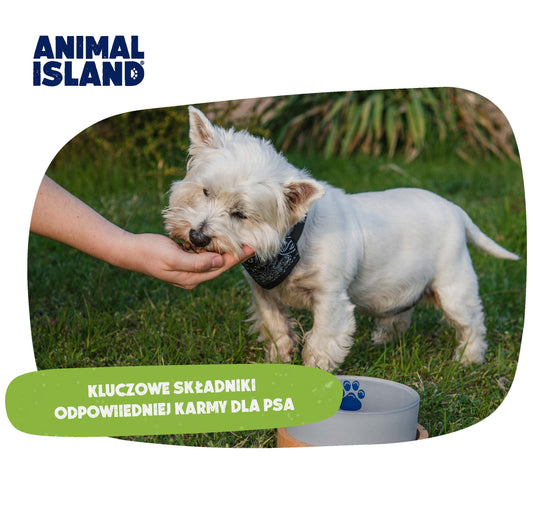Can Dogs See Colors? Why Do Dogs Need Whiskers? Fun Facts About Dogs

How Do Dogs See? What Do They Feel and Hear? Interesting Facts About Dog Senses
Dog senses and exploring the world…
A dog, like a human, explores the world using its senses. The most important for your pet is of course its nose and sense of smell. But your quadruped also uses other organs and senses. See how it does it! How do dogs see? What do they hear and feel? Here are a few interesting facts from the world of dog senses.
Do Dogs See Colors?
On the Internet, you can still come across the statement that Dogs do not see colors. This is not true! Your Puppy sees colors and distinguishes them, although they are slightly dimmed and sees them differently than you. How? The color purple is dark blue to a Dog, blue is light blue, and green is gray. Instead of yellow and orange - your Dog sees light yellow and dark yellow. The color red causes the most problems for Dogs, which they register as gray or black.
However, it is not the colors that are most important for a Dog, but their brightness and contrasts. When choosing balls to play with, choose those that are definitely lighter or darker than the ground on which you will be playing - a green ball thrown into the grass may turn out to be a frustrating gadget for a Dog.
The dog's eye is equipped with an additional layer that effectively reflects light. This is a reflective membrane (reflective tapestry), built in the dog from cells containing guanine crystals. How does it work? The light reflected from the membrane is directed to the photoreceptors, thanks to which the dog sees well at night and in poor lighting. The effect of the dog's glowing eyes is created as a result of the reflection of light from the reflective membrane.
Sight is the sense that is least important to Dogs. And which organ is most important in terms of exploring the world? The nose, of course!
Dog's Smell
You can guess that your dog's nose is definitely more sensitive and accurate at identifying smells than yours, right? Have you ever wondered what the difference is? Here are some numbers that explain it and are really impressive! Humans have about 5 million olfactory cells, while dogs have 120 to even 200 million! In addition, canine olfactory cells have a surface area almost 300 times larger than human olfactory cells. The moisture of a dog's nose is also important for effectively locating the source of odors. With a sense of smell that is 10,000 to even 100,000 times stronger than humans, dogs can be a great support for people. Animals work in uniformed services, supporting police officers and border guards in tracking down missing people and searching for and detecting dangerous substances. Bloodhounds can track down scents that are... over 300 hours old!
But that's not all! It has been proven that dogs of selected breeds can also "sniff out" various diseases. The animals can sense, among others, some cancers (lung, skin, breast, bladder and prostate), diabetes and potentially dangerous fluctuations in blood glucose, as well as... an approaching epileptic seizure. Research is ongoing on how dogs can indicate people infected with the COVID -19 virus.
Dogs love various types of sniffing games. You can use sniffing mats or create games yourself, which will involve, for example, sniffing out a favorite treat under cups or finding a favorite toy hidden in the house. Games that use a dog's nose help to calm down and focus. They can also be an important therapeutic tool.
In addition, a dog's nose is an identifier for your Pet, just like your fingerprint is an identifier for you. No two dog's noses are the same!
Dog's Whiskers
A dog receives tactile sensations with its entire body, just like a human. Dogs also have whiskers, the so-called vibrissae, which allow animals to explore their surroundings even more intensively and precisely through touch. The whiskers are so sensitive that even in complete darkness, a dog can safely avoid obstacles by recognizing their shape and texture with the help of their whiskers! Amazing, isn't it?
Remember that whiskers should not be trimmed! Their length should also be taken into account when choosing the size of the bowl - it should allow for free intake of food or water, without irritating the sensitive whiskers of your Pupil.
A dog's sense of taste
A dog has five times fewer taste buds on its tongue than you do! A dog has about 1,700 taste buds, while a human has about 9,000. All taste receptors are located on the tip of a dog's tongue, and your dog can distinguish between the basic tastes: sweet, salty, bitter, and sour. For your pet, the smell of food is definitely more important than its taste.
Dog Hearing
Dogs have excellent hearing, which is second only to smell in the ranking of the importance of canine senses. Your Pupil can locate the source of a sound in 0.06 seconds! This exceptional efficiency is due, among other things, to the rotating ears, which are controlled by 17 separate muscles. Dogs with long, hanging and relatively heavy ears are in a slightly worse situation, which effectively block the possibility of sound reaching the interior of the ear. While you hear sounds with a frequency of up to 2 thousand Hz best, your dog's hearing works perfectly and picks up sounds with a frequency of 4.7 to even 8 thousand Hz. In addition, dogs can hear ultrasound, although they cannot emit it, as dolphins and bats do. High-pitched sounds made by household appliances, as well as thunderstorms, can be a downright painful experience for your dog!

Brain and Body – How is a Dog Built?
Your Dog is made of… love! That much is obvious! What else?
Dog Brain Anatomy
The dog brain, like the human brain, can develop if it receives the right stimuli at the right time. Dogs have about 530 million neurons in their cerebral cortex – humans have about 16 billion, and cats… only 250 million. Dogs can not only learn up to 250 words and phrases/commands, but also recognize and interpret the tone in which they are said. Just like you! A good job said with enthusiasm by your boss is completely different from a good job said cynically and angrily.
Dog Anatomy - Interesting Facts About the Dog's Body
The dog's skeleton is made up of 319 bones. That's 112 more bones than in the human skeleton! Dog shoulder blades are not attached to the skeleton, which gives the animal greater freedom of movement and flexibility when running. Do you know which dogs are the fastest in the world? No, it's not your Pupil who stole the tastiest piece of meat from your plate and is running away with it! We're talking about representatives of the Greyhound breed, which can reach speeds of up to 70 km/h.
Toes? Modern Dogs move by supporting their weight on five-toed front paws and four-toed hind paws. Most Dogs have an additional and completely unnecessary claw on their hind legs. This is the so-called dewclaw, a remnant of dog ancestors who moved on four five-toed limbs. The Norsk Lundehund breed is unique in terms of the number of toes - its representatives have six toes in each paw!
Does your dog sweat? Yes! But only on… the pads of their paws! It's easy to guess that this is not enough surface area for effective cooling during hot weather. Dogs take care of this by simply panting. And since we're on the subject of dog paws… Where does that sweet, slightly corn-like smell of your friend's paws come from, which Americans call Fritos feet? We warn you, the answer to this question is not the most delicious! The unique smell of dog paws is caused by the bacteria Pseudomonas and Proteus, which are perfect for finding their way between dog toes and… smell like popular corn chips.
Dogs can have one of as many as 13 different blood groups, while humans have four, horses eight, and cows nine.
Dog Teeth
Dogs are born without teeth. The first baby teeth start to grow in a puppy around 3-4 weeks of age (most often these are incisors), and the rest should develop by 6-8 weeks of age. Dogs have a total of 28 baby teeth, closely spaced and very sharp. If your dog comes to you as a puppy, you will witness the replacement of baby teeth with permanent teeth, which begins around 3 months of age and usually ends between 6 and 8 months of age. Permanent teeth? Your pet will most likely have as many as 42 of them - 22 in the maxilla and 20 in the mandible. Dog teeth are built exactly like human teeth (crown, neck, root) and are divided into incisors, canines, premolars and molars.
The time and pace of teeth eruption and the replacement of milk teeth with permanent teeth are subject to individual conditions, just like in humans, and minor deviations from the norm are not a cause for concern. Any differences in the number of permanent teeth may result from different dental patterns for individual breeds. Did you know that your dog may have a malocclusion? A dog's correct bite is formed in the first six months of life. In most dogs, the correct bite is a scissors bite, which developed during the process of domesticating dogs. The primary bite is a pincer bite, which is typical for most herding breeds. The most common malocclusions in dogs include an underbite (correct only in breeds with a brachycephalic skull structure, e.g. bulldogs) and an underbite (considered a defect in all dog breeds!).
Dogs and emotions
Did you know that when a Dog stares into your eyes, he looks for clues in them? Your Dog is the definition of friendship and loyalty. However, a Pupil who is gazing at his guardian can feel a wide range of different emotions. Your pet can also easily decipher your emotions! Scientists say that humans and Dogs are the only two species that look into each other's eyes and look for clues in them, and your Dog looks for these clues only in humans.
Dogs can feel jealousy. You can experience it in everyday situations, for example, when you hug your partner (instead of your Dog, but how?!) or pet your neighbor's Dog. That's not all! Dogs also understand the concept of honesty and can get really offended when they are treated unfairly, for example, when another Dog gets a bigger snack as a reward for the same work (e.g. during training or learning tricks). In addition, dogs can sense deceit in the behavior of a human when they have something on their conscience. Dogs do not use the concepts of good and evil - they assess each situation based on whether it is safe for them or quite the opposite. Guilty face on a Dog? No illusions! Your Puppy, even after eating your favorite slippers and dealing with your book collection - does not feel guilty! Although of course he feels bad because of your anger and disappointment with his... idea.
How to calculate a dog's age?
Do everything you can to make your Dog live long and happy! You have certainly heard the statement that it is enough to multiply the Dog's age by seven to get the answer to the question: how old is the Dog in human years? This is an average value, which, however, does not give a full picture in this matter. When calculating the age of the Dog, the size and breed of the Animal are also taken into account. The multiplier can also change during the Dog's life. For example, a one-year-old Small Dog is a twenty-year-old, a one-year-old Medium Dog is an eighteen-year-old, and a one-year-old Large Dog is just a twelve-year-old adolescent. The same Dogs, at the age of five, will be 40, 45, and 48 years old, respectively, and after another five years of life: 58, 75, and 82 years old.
Small and medium-sized dogs mature faster, but enjoy adulthood for a longer period of time. Large dogs, on the other hand, mature slower, but the aging process takes its toll on them much faster. An eight-year-old Chihuahua will therefore be in full force, while an eight-year-old St. Bernard will be called a senior dog. The longest-living dogs include representatives of small breeds, such as Chihuahuas, Miniature Pinschers, and Miniature Poodles. Representatives of larger breeds, such as the Irish Wolfhound, English Bulldog, and Great Dane, live the shortest.
Officially, the longest living dog is considered to be an Australian Cattle Dog named Bluey. The dog's owner was an Australian farmer, Les Hall, for whom Bluey worked, guarding herds of sheep and cattle. The Guinness Book of Records provides the dates of birth and death of the animal - Bluey was born on June 7, 1910 and was put down on November 14, 1939, having lived for over 29 years. Various sources indicate that the record holder in the longevity category is a female dog, Chilla, of the Australian Cattle Dog breed, who was supposed to have lived for 32 years and 12 days. However, this information has not been sufficiently documented and Chilla has not been entered into the Guinness Book of Records.
The world of interesting facts about Dogs is… virtually inexhaustible!
How many interesting facts about Dogs did you know? Which ones completely surprised you? We hope that we have awakened in you a hunger for knowledge, thanks to which you will observe your Pupil with even greater attention and fascination! Scientists emphasize that Dogs are the most diverse species of animals in the world. Who knows what else our quadrupeds will surprise us with?













